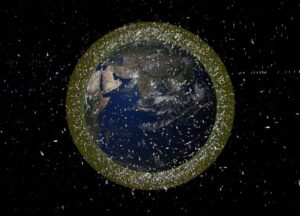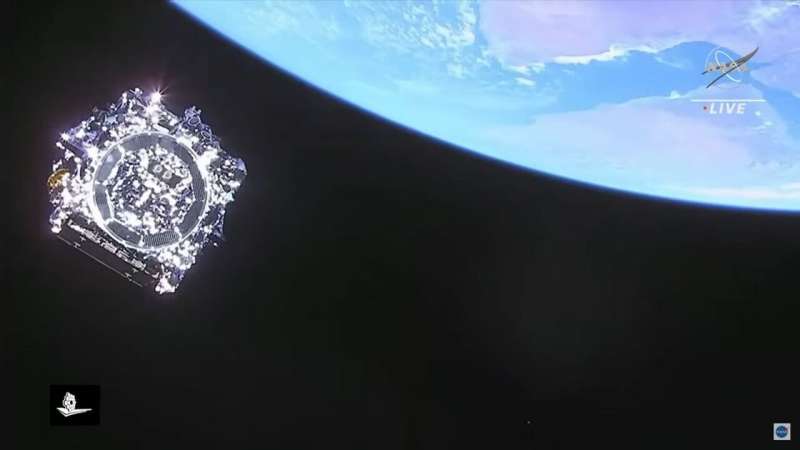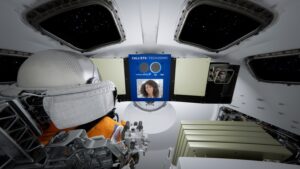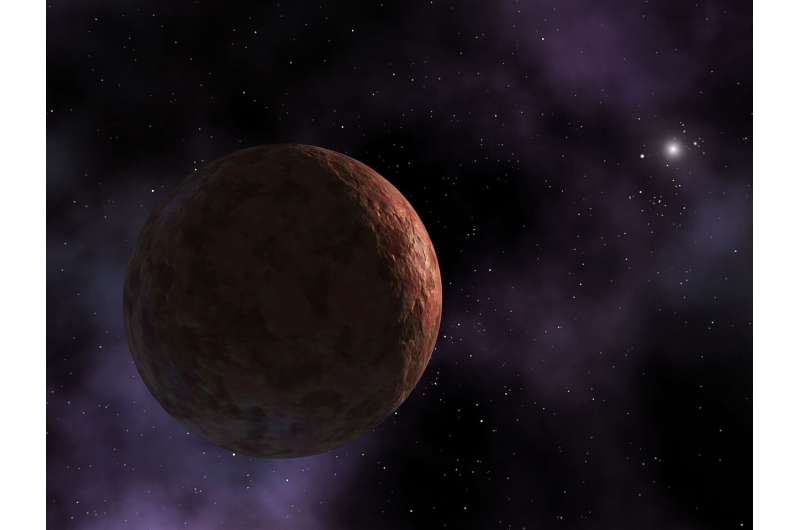Space Force wants to help fund technologies to recycle, reuse or remove space debris
Wednesday, 05 January 2022 20:08
Vice Chief of Space Operations Gen. David Thompson in a video released Jan. 5 called on the private sector to help clean up space junk.
Webb telescope deploys flap that will keep it oriented during its mission
Wednesday, 05 January 2022 13:24
On December 25, 2021, astronomers and space exploration enthusiasts got the greatest Christmas present of all—after years of delays, cost overruns and additional testing, the James Webb Space Telescope (JWST) launched from Europe's Spaceport in Kourou, French Guiana. In a real nail-biter, the Ariane 5 rocket and its precious payload reached orbit without a hitch. But as is so often the case, the deployment of the JWST was just the first in a series of "hurry-up-and-wait" episodes.
Typically, periods of waiting are accompanied by plenty of worry and doubt. Luckily, there have been several positive developments since the JWST launched that could alleviate these anxieties. The latest is that the telescope successfully deployed its aft momentum flap, an instrument that will keep the telescope oriented during its mission. The news was announced yesterday (December 30) via @NASAWebb, NASA's official Twitter account for the Webb telescope, and the JWST page at NASA Blogs.
According to NASA Blogs, the deployment of the aft momentum flap began at 09:00 AM EST (06:00 AM PST) and lasted about eight minutes. During this time, the mission team released the flap's hold-down devices while a spring brought the flap into its final position.
Amazon’s Alexa to be tested on Artemis 1
Wednesday, 05 January 2022 12:00
The upcoming uncrewed test flight of the Orion spacecraft will include a payload to see how a voice recognition technology widely available to consumers today could be used to assist astronauts on future missions.
2029 will be the perfect year to launch a mission to Sedna
Wednesday, 05 January 2022 11:13
Object 90377 Sedna—a distant trans-Neptunian object known best for its highly elliptical, 11,390-year long orbit—is currently on its way toward perihelion (its closest approach to the sun) in 2076. After that, Sedna will swing out into deep space again and won't be back for millennia, making this flyby a once-in-a-lifetime (or, once in ~113 lifetimes) opportunity to study an object from the far reaches of our solar system. There are no missions to Sedna in the works just yet, but astronomers are beginning to plan for the possibility, and the ideal launch date for such a mission is approaching fast, with two of the best launch windows coming up in 2029 and 2034.
Sedna was discovered in 2003 by Caltech astronomer Mike Brown and his team, and was one of a series of potential dwarf planets (alongside similar-sized bodies like Haumea, Makemake, and Eris) whose discovery led to the demotion of Pluto in 2006. As best we can tell from a distance, Sedna is about the same size as Ceres, the largest object in the asteroid belt, but its composition and origins are different.
Space business: The final (profitable) frontier
Wednesday, 05 January 2022 08:31 The snub-nosed craft resembles a shuttle-airplane mashup, and is the latest entrant in a profit-seeking push with staggering potential - and risks - for humans to visit, work or even live in space.
The display of technology like the life-size model "Dream Chaser" ship at the CES tech show in Las Vegas is a sharp signal that the commercial space era is upon us.
Experts see a path for
The snub-nosed craft resembles a shuttle-airplane mashup, and is the latest entrant in a profit-seeking push with staggering potential - and risks - for humans to visit, work or even live in space.
The display of technology like the life-size model "Dream Chaser" ship at the CES tech show in Las Vegas is a sharp signal that the commercial space era is upon us.
Experts see a path for Sunshield deploys on NASA's Next Flagship Telescope
Wednesday, 05 January 2022 08:31 The James Webb Space Telescope team has fully deployed the spacecraft's 70-foot sunshield, a key milestone in preparing it for science operations. The sunshield - about the size of a tennis court at full size - was folded to fit inside the payload area of an Arianespace Ariane 5 rocket's nose cone prior to launch. The Webb team began remotely deploying the sunshield Dec. 28, 2021, three days aft
The James Webb Space Telescope team has fully deployed the spacecraft's 70-foot sunshield, a key milestone in preparing it for science operations. The sunshield - about the size of a tennis court at full size - was folded to fit inside the payload area of an Arianespace Ariane 5 rocket's nose cone prior to launch. The Webb team began remotely deploying the sunshield Dec. 28, 2021, three days aft Resolving the black hole 'fuzzball or wormhole' debate
Wednesday, 05 January 2022 08:31 Black holes really are giant fuzzballs, a new study says. The study attempts to put to rest the debate over Stephen Hawking's famous information paradox, the problem created by Hawking's conclusion that any data that enters a black hole can never leave. This conclusion accorded with the laws of thermodynamics, but opposed the fundamental laws of quantum mechanics.
"What we found from strin
Black holes really are giant fuzzballs, a new study says. The study attempts to put to rest the debate over Stephen Hawking's famous information paradox, the problem created by Hawking's conclusion that any data that enters a black hole can never leave. This conclusion accorded with the laws of thermodynamics, but opposed the fundamental laws of quantum mechanics.
"What we found from strin China plans missions to moon's south pole
Wednesday, 05 January 2022 08:31 China has approved the fourth phase of its lunar exploration program, including a basic model of a research station built on the moon over the coming decade, according to the China National Space Administration.
Wu Yanhua, deputy director of the administration, said China would carry out lunar exploration in the future Chang'e-6, Chang'e-7 and Chang'e-8 missions.
As planned, Chang'e-
China has approved the fourth phase of its lunar exploration program, including a basic model of a research station built on the moon over the coming decade, according to the China National Space Administration.
Wu Yanhua, deputy director of the administration, said China would carry out lunar exploration in the future Chang'e-6, Chang'e-7 and Chang'e-8 missions.
As planned, Chang'e- Flight 19 - New Year, Same Ingenuity
Wednesday, 05 January 2022 08:31 The next flight on Mars marks the first of 2022 and the nineteenth for NASA's Ingenuity Mars Helicopter. The current mission goal is to reach the Jezero river delta to aid the Perseverance rover in path planning and scientific discovery.
This flight, which will take place no earlier than Friday, Jan. 7, takes the scout vehicle out of the South Seitah basin, across the dividing ridge, and u
The next flight on Mars marks the first of 2022 and the nineteenth for NASA's Ingenuity Mars Helicopter. The current mission goal is to reach the Jezero river delta to aid the Perseverance rover in path planning and scientific discovery.
This flight, which will take place no earlier than Friday, Jan. 7, takes the scout vehicle out of the South Seitah basin, across the dividing ridge, and u Sols 3347-3348: Bem Vindo a Roraima!
Wednesday, 05 January 2022 08:31 Tosol, Curiosity woke up in a new mapping quadrant, Roraima. The Roraima quadrant is named after the northern-most state of Brazil and Mount Roraima, which is the highest peak in the Pakaraima mountains which sits between Brazil, Venezuela, and Guyana.
The terrain in the Roraima region on Earth looks somewhat similar to the area Curiosity is in - with flat-topped hills and some steep slope
Tosol, Curiosity woke up in a new mapping quadrant, Roraima. The Roraima quadrant is named after the northern-most state of Brazil and Mount Roraima, which is the highest peak in the Pakaraima mountains which sits between Brazil, Venezuela, and Guyana.
The terrain in the Roraima region on Earth looks somewhat similar to the area Curiosity is in - with flat-topped hills and some steep slope China's Mars orbiter captures series of selfies using remote camera
Wednesday, 05 January 2022 08:31 The China National Space Administration released photos on New Year's Day, of its Mars orbiter circling high above the Red Plant.
The selfies were taken by a small camera which was deployed by the Tianwen 1, capturing images of the orbiter and sending them back to it via a WiFi connection.
The photos were then relayed back to Earth where they were published by China's space agenc
The China National Space Administration released photos on New Year's Day, of its Mars orbiter circling high above the Red Plant.
The selfies were taken by a small camera which was deployed by the Tianwen 1, capturing images of the orbiter and sending them back to it via a WiFi connection.
The photos were then relayed back to Earth where they were published by China's space agenc How scientists designed the orbit of the Chang'E 5 mission
Wednesday, 05 January 2022 08:31 In the early morning of November 24, 2020, the Chang'E 5 lunar probe was launched from the Wenchang Space Launch Center and successfully executed a 23-day journey of lunar sample return (LSR) mission. In a review paper recently published in Space: Science and Technology, Dr. Zhong-Sheng Wang and his colleagues from the Beijing Institute of Spacecraft System Engineering, addresses three key orbit
In the early morning of November 24, 2020, the Chang'E 5 lunar probe was launched from the Wenchang Space Launch Center and successfully executed a 23-day journey of lunar sample return (LSR) mission. In a review paper recently published in Space: Science and Technology, Dr. Zhong-Sheng Wang and his colleagues from the Beijing Institute of Spacecraft System Engineering, addresses three key orbit Quadrantid meteor shower offers good show outside of North America
Wednesday, 05 January 2022 08:31 The Quandrantid meteor shower helped kick off the first workday of the new year on Monday, with the peak somewhat tough to see in North America - but the rest of the world got a good show.
The "Quads" as they are nicknamed, are slated to peak around 4 p.m. EDT (2100 GMT) on Monday, according to Margaret Campbell-Brown and Peter Brown in the 2022 version of the Observer's Handbook of th
The Quandrantid meteor shower helped kick off the first workday of the new year on Monday, with the peak somewhat tough to see in North America - but the rest of the world got a good show.
The "Quads" as they are nicknamed, are slated to peak around 4 p.m. EDT (2100 GMT) on Monday, according to Margaret Campbell-Brown and Peter Brown in the 2022 version of the Observer's Handbook of th Asteroid 'Apophis' predicted to skim dangerously close to Earth in 2029
Wednesday, 05 January 2022 08:31 Earlier, NASA said that Apophis - the poster child for "hazardous asteroids" - was no longer deemed a threat for Earth based on a refined estimate of its orbit around the Sun.
Asteroid 99942 Apophis, estimated to measure 340 metres (1,100 ft) across and identified by the National Aeronautics and Space Administration (NASA) as one of the most hazardous asteroids that could impact Earth, wil
Earlier, NASA said that Apophis - the poster child for "hazardous asteroids" - was no longer deemed a threat for Earth based on a refined estimate of its orbit around the Sun.
Asteroid 99942 Apophis, estimated to measure 340 metres (1,100 ft) across and identified by the National Aeronautics and Space Administration (NASA) as one of the most hazardous asteroids that could impact Earth, wil The mysterious dusty object orbiting TIC 400799224
Wednesday, 05 January 2022 08:31 The Transiting Exoplanet Survey Satellite, TESS, was launched in 2018 with the goal of discovering small planets around the Sun's nearest neighbor stars. TESS has so far discovered 172 confirmed exoplanets and compiled a list of 4703 candidate exoplanets. Its sensitive camera takes images that span a huge field of view, more than twice the area of the constellation of Orion, and TESS has also as
The Transiting Exoplanet Survey Satellite, TESS, was launched in 2018 with the goal of discovering small planets around the Sun's nearest neighbor stars. TESS has so far discovered 172 confirmed exoplanets and compiled a list of 4703 candidate exoplanets. Its sensitive camera takes images that span a huge field of view, more than twice the area of the constellation of Orion, and TESS has also as 